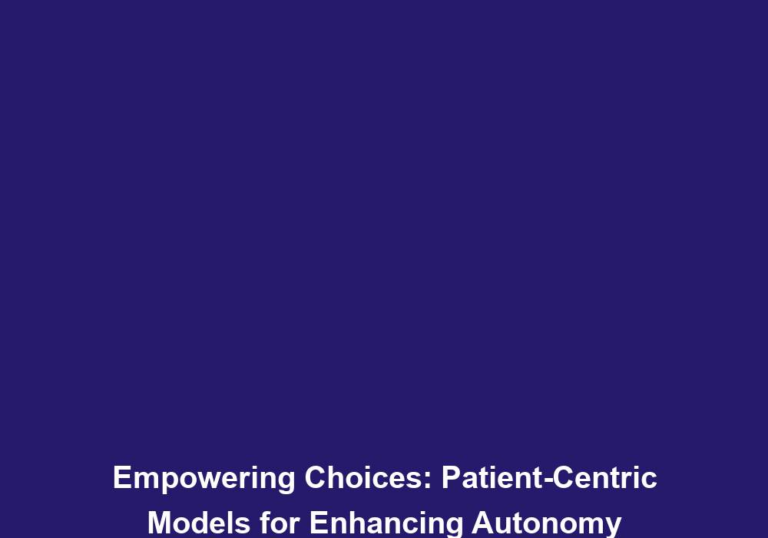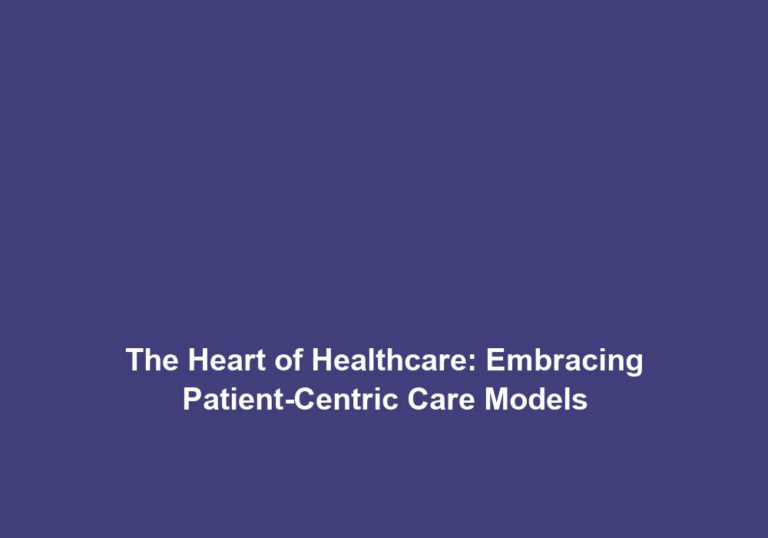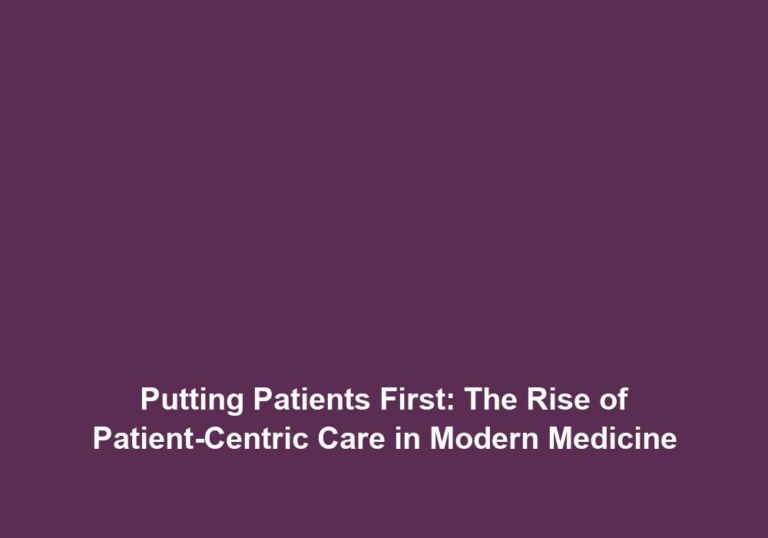Decision Dynamics: Enhancing Patient Autonomy in Centric Care
In today’s healthcare landscape, patient autonomy plays a vital role in the delivery of quality care. As healthcare providers strive to become more patient-centric, the concept of decision dynamics emerges as a crucial aspect of enhancing patient autonomy. This article explores the importance of decision dynamics and how it can empower patients to actively participate in their healthcare journey.
Understanding Decision Dynamics
Decision dynamics refer to the intricate interplay between healthcare providers, patients, and the decision-making process. It involves engaging patients in shared decision-making, considering their unique circumstances, preferences, and values. By fostering a collaborative environment, decision dynamics ensure that patients have a significant role in determining their treatment plans, improving the overall patient experience.
Importance of Shared Decision-Making
Shared decision-making is a key component of decision dynamics. It involves a collaborative approach between healthcare providers and patients, where both parties actively participate in the decision-making process. Through open and honest communication, patients are informed about the available treatment options, potential risks and benefits, and have the opportunity to voice their preferences. This shared decision-making process not only empowers patients but also enhances their understanding of their health condition and treatment options.
Considering Patient’s Unique Circumstances
Decision dynamics also require healthcare providers to consider each patient’s unique circumstances. This includes factors such as their medical history, lifestyle, values, and preferences. By taking into account these individual factors, healthcare providers can tailor treatment plans to meet the specific needs of each patient. This personalized approach not only improves treatment efficacy but also enhances patient satisfaction and engagement in their own healthcare.
Fostering a Collaborative Environment
Creating a collaborative environment is essential for decision dynamics to thrive. This involves healthcare providers actively listening to patients, acknowledging their values and beliefs, and incorporating them into the decision-making process. By respecting patient preferences and involving them in the decision-making process, healthcare providers can establish a patient-centric approach that values patient autonomy. This collaborative environment fosters trust and strengthens the doctor-patient relationship, leading to improved patient satisfaction.
The Significance of Patient Autonomy
Patient autonomy refers to the right and ability of patients to make informed decisions regarding their healthcare. It recognizes the individuality of patients and their right to have a say in their treatment options. By respecting patient autonomy, healthcare professionals acknowledge that patients are experts in their own lives and that their values and preferences should guide the decision-making process.
Empowering Patients through Informed Decision-Making
When patients are empowered to make informed decisions about their healthcare, they assume an active role in their treatment journey. This empowerment gives them a sense of control and ownership over their health, leading to increased confidence and engagement. By involving patients in the decision-making process, healthcare providers not only respect their autonomy but also improve patient satisfaction and overall health outcomes.
Recognizing Patient Expertise
Healthcare providers should recognize that patients possess valuable expertise about their own lives and experiences. By acknowledging this expertise, healthcare professionals can better understand the unique needs and preferences of each patient. This recognition fosters a collaborative approach where patients and healthcare providers work together to develop treatment plans that align with the patient’s values and goals. By valuing patient expertise, healthcare providers empower patients to actively participate in their healthcare decisions.
Supporting Informed Consent
Informed consent is a fundamental aspect of patient autonomy. Healthcare providers should ensure that patients have a clear understanding of their treatment options, including potential risks, benefits, and alternatives. By providing patients with comprehensive and understandable information, healthcare professionals enable patients to make autonomous decisions based on their individual needs and preferences. Supporting informed consent not only respects patient autonomy but also promotes trust and transparency in the doctor-patient relationship.
Benefits of Enhancing Patient Autonomy
Enhancing patient autonomy through effective decision dynamics yields several key benefits:
-
Improved Patient Satisfaction: When patients feel empowered and involved in their healthcare decisions, their overall satisfaction with the healthcare experience increases. This fosters a positive doctor-patient relationship and enhances patient trust.
-
Better Treatment Adherence: Patients who actively participate in their treatment decisions are more likely to adhere to the prescribed treatment plan. They have a sense of ownership and responsibility, leading to improved treatment outcomes.
-
Increased Patient Engagement: Engaging patients in decision-making fosters a sense of engagement and involvement in their own healthcare. This active participation has been linked to better health outcomes and increased patient engagement in self-care.
-
Personalized Care: Decision dynamics allow healthcare providers to tailor treatment plans to individual patients. By considering patients’ values and preferences, personalized care can be delivered, leading to better treatment efficacy and patient satisfaction.
Improved Patient-Provider Communication
Enhancing patient autonomy also improves patient-provider communication. When patients are actively involved in the decision-making process, they are more likely to openly communicate their concerns, questions, and preferences. This open communication fosters a collaborative relationship between patients and healthcare providers, where both parties work together to achieve the best possible health outcomes. Improved patient-provider communication not only enhances the patient experience but also reduces the likelihood of medical errors and misunderstandings.
Empowering Patients as Active Participants in Their Healthcare
By enhancing patient autonomy, healthcare providers empower patients to become active participants in their healthcare. This shift from a passive recipient of care to an engaged participant allows patients to take control of their health and make decisions that align with their values and preferences. Empowered patients are more likely to adhere to treatment plans, engage in self-care, and actively seek out information and support. This active participation ultimately leads to better health outcomes and improved patient satisfaction.
Strategies to Enhance Decision Dynamics
To enhance decision dynamics and promote patient autonomy, healthcare providers can adopt the following strategies:
1. Shared Decision-Making:
Shared decision-making involves a collaborative approach between patients and healthcare providers. Through open and honest communication, patients are informed about the available treatment options, potential risks and benefits, and actively participate in the decision-making process. Decision aids, such as informational brochures or online tools, can facilitate shared decision-making.
2. Patient Education:
Educating patients about their health condition, treatment options, and potential outcomes is vital for informed decision-making. Healthcare providers can empower patients by providing them with understandable and reliable information, allowing them to make choices based on their individual needs and preferences. This education can be provided through one-on-one discussions, educational materials, or online resources.
3. Respect for Patient Preferences:
Respecting patient preferences is crucial for enhancing decision dynamics. Healthcare providers should actively listen to patients, acknowledge their values and beliefs, and incorporate them into the decision-making process. This fosters a patient-centric approach and promotes patient autonomy. By involving patients in the decision-making process, healthcare providers can ensure that treatment plans align with the patient’s goals and values.
4. Clear and Accessible Information:
Healthcare providers should ensure that medical information is presented in a clear and understandable manner. Avoiding medical jargon and using plain language helps patients comprehend their options and actively engage in decision-making. Accessible information promotes shared decision-making and empowers patients to make informed choices. This can be achieved through the use of visual aids, simplified explanations, and easy-to-understand written materials.
5. Ongoing Communication:
Maintaining open lines of communication throughout the healthcare journey is essential for decision dynamics. Regular follow-ups, check-ins, and reassessments allow patients to discuss any concerns or questions they may have. This ongoing communication ensures that patients remain actively involved and supported in their decision-making process. Healthcare providers should encourage patients to ask questions, voice their concerns, and provide updates on their health status. By fostering ongoing communication, healthcare providers can address any changes or challenges that arise and make adjustments to the treatment plan as necessary.
Conclusion
In conclusion, decision dynamics and the enhancement of patient autonomy are crucial for providing patient-centered care. By involving patients in the decision-making process, healthcare providers empower them to make informed choices, leading to improved treatment adherence, increased patient satisfaction, and better health outcomes. Adopting strategies such as shared decision-making, patient education, and respecting patient preferences can effectively enhance decision dynamics, fostering a collaborative healthcare environment and prioritizing patient autonomy.






